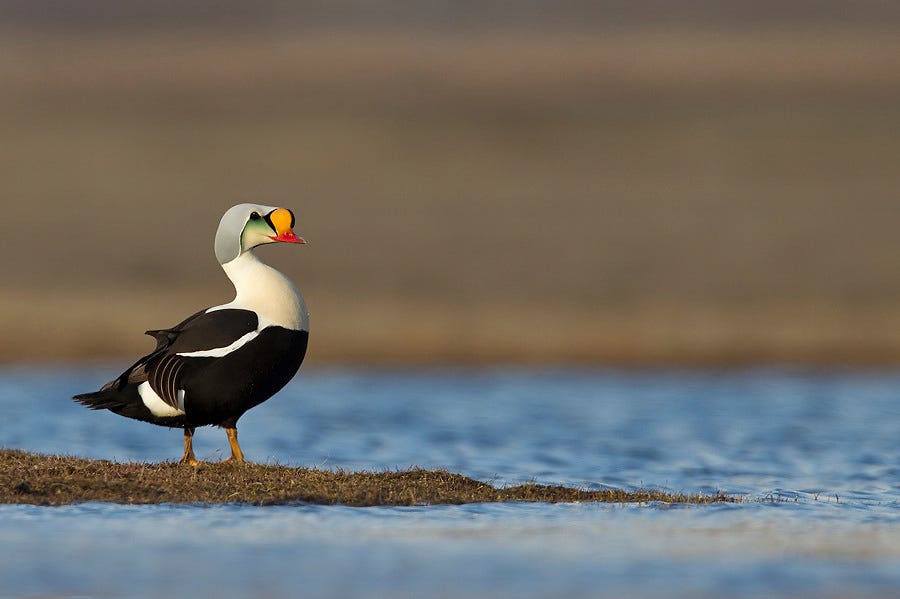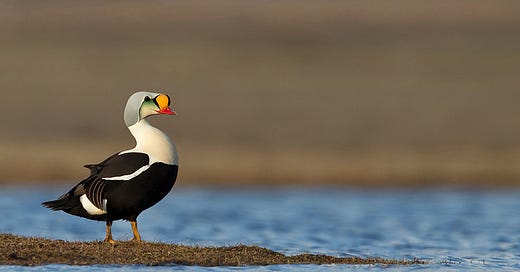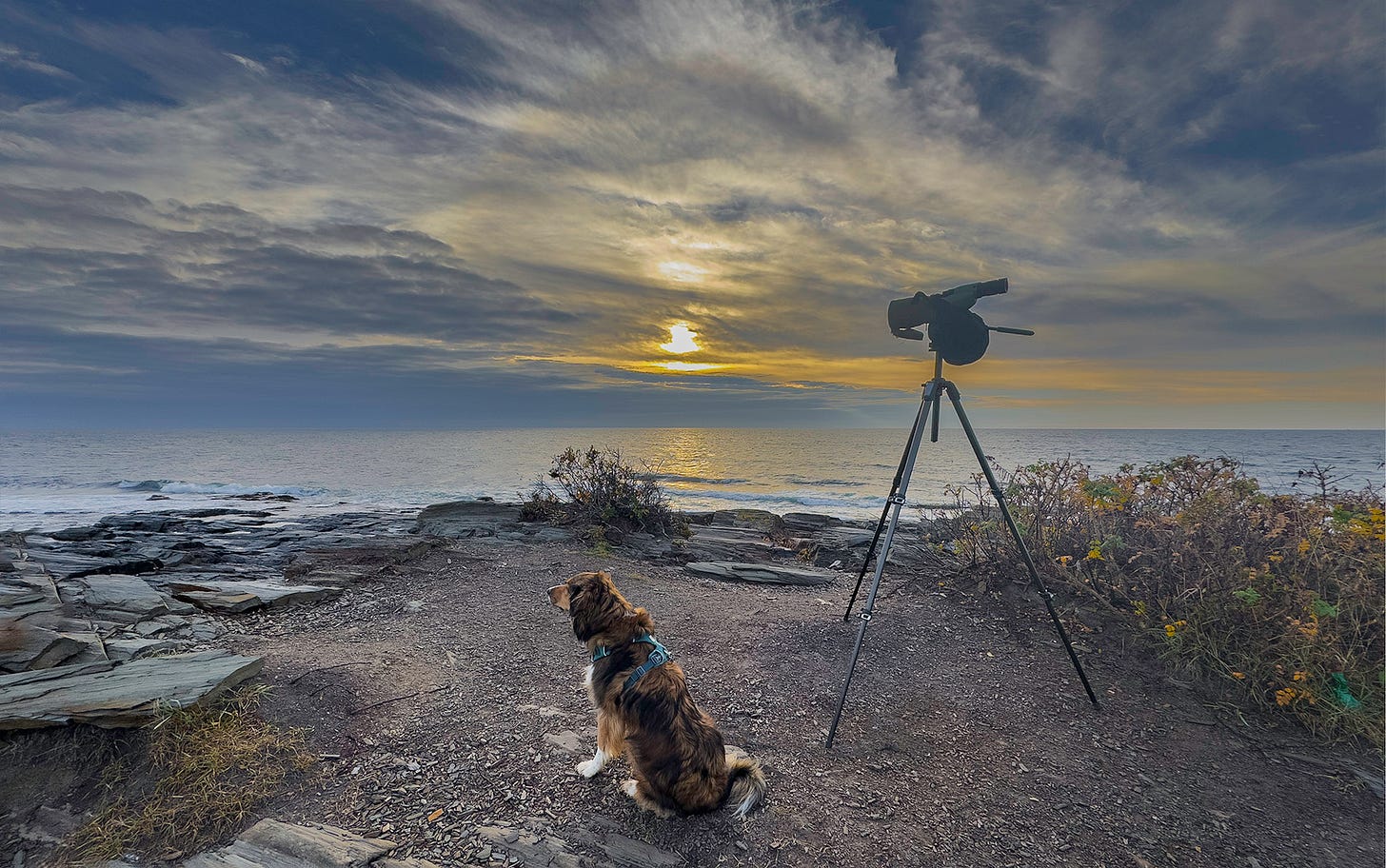
WHEN YOU first gaze upon a King Eider, a moment that can change a birdwatcher’s life, your impression may very well be that of confusion. Is this duck beautiful? Or bizarre?
It is both, of course, as if a child had conjured up a fictional waterfowl. And yet, as it floats just offshore in icy waters, a King Eider, authentic and honest, is a reminder of genuine beauty in a world of inevitable pain and chaos. This is quite a burden for a sea duck to bear.
A week after the U.S. election, I will largely stay in my usual lane here at Chasing Nature, leaving the political postmortem to others. Decades ago, practically another lifetime, before newspapers became endangered (like plants and animals), I was a journalist covering state and national politics. I know well that elections produce winners and losers. And yet to look at what’s become of governance here in the U.S., it seems that ultimately we are all losers — or will be unless transformation comes to our polity.
Which is in part why after the election I went to the ocean with Ruth and our pup Odin to regain my footing among loons and grebes, gannets and gulls, and most of all among the eiders and scoters and other sea ducks floating along the coast of Maine. Watching seabirds, a particular genre of birding, is not solely about the birds, but also, for the watcher, about way of being. Slow and contemplative, seabirding certainly won’t cure what’s gone awry in the world, but it helps me find my bearings, perhaps equanimity.
During seabirding, rather than wandering around in hot pursuit, looking up into trees and peering into shrubs for birds flitting about, a birder simply claims a high spot on shore at dawn and welcomes what floats in the surf or flies over a vast blue stage. We seabirders are neither covetous nor impatient, but instead at ease and yet alert. When a bird comes into view, we consider its plumage and how it carries itself in flight, we decide on its identity, and we admire its beauty or oddity (or both). Then we wait and watch for more of what may come.
All the while, looking out to sea for hours, a seabirder’s mind might drift like the waves themselves — toward a Harbor Seal floating in the surf, toward a team of lobstermen hauling traps into their boat, toward politics and community, toward the gentle curvature of earth at the horizon, even toward notions of love and pain and impermanence. Then another bird draws us back to the certainty of sea and sky and feathers — and to discovery.
A Common Loon, for example, is gangly and dorky in flight, with a big head in front and feet dangling straight back. A Red-throated Loon, by comparison, displays a daintier head and smaller feet, and looks around at the scenery as it flies past your vantage on shore. Although the distinctions may seem clear in my side-by-side images, a novice birder watching a solitary loon at a distance might not know or see the nuance — until with practice the nuance becomes a kind of epistemology, a form of beauty and satisfaction found purely in knowledge and awareness, and even in doubt.
And then comes the antithesis of nuance: A Northern Gannet, incontrovertible, whiter than the whitecaps, a spear with daggers for wings, plunge-dives for fish like a harpoon carried around and hurled into the sea by the wind’s invisible hand. I can easily spend hours watching gannets at sea. On this outing, however, I found myself drawn most of all to birds that breed even farther north in the high Arctic: there before me, a conviction of sea ducks.
Harlequin Duck needs no explanation from me, other than to point out that while guiding birdwatching trips to the coast, I used to ask who among my group had not ever seen a Harlequin Duck. Then, upon parking the van at our seawatching spot, as various birders in the group walked toward shore I would ask the neophytes to stay back with me as I gathered gear and other supplies.
“Why?” they would ask.
“Because I want to be at your side when you first behold a Harlequin Duck,” I replied. “I want to savor your ‘OH-MY-GOD!’ moment.” (It’s what we call job satisfaction in the guiding business.)
Next up for me in Maine, the Surf Scoters — displaying clown bills, fat heads, and the capacity to make white look garish — allowed me to chuckle at wildlife only days after the election. By contrast, the Long-tailed Ducks were expressions of elegance at a time of vulgarity in public discourse and in what now passes for political leadership.
As it turned out, I did not see a King Eider during my post-election seawatching trip. No matter. I nonetheless found my respite. King Eiders, after all, are rare prizes on the north Atlantic coast in November. Nothing in nature is certain and predictable — except perhaps the tides, relentless as gravity, the ocean breathing.
Nor is anything in human affairs certain and predictable — not elections, not justice, not democracy. So whether we might find solace and strength among songbirds or forests, among family or community, even among odd ducks or lame ducks, we are like the tides: still breathing.
There is new work ahead.
Postscripts
Did you happen to notice the fins (sexual ornaments) on the back of the King Eider in the banner image above?
Image credits: Common Loon ©Cinnamon3250 via Wikimedia Commons; Red-throated Loon © Joshua Lincoln (with permission); Harlequin Duck © Brian Stahls via iNaturalist; Surf Scoter © Zein et Carlo via iNaturalist; Long-tailed Duck © Dennis Doucet via iNaturalist. Except for Josh’s, all images CC BY-NC 4.0.








Thank you, Brian. I needed to hear the ocean is still breathing, and beautiful birds still fly.
I love your writing, and the pictures you paint: “All the while, looking out to sea for hours, a seabirder’s mind might drift like the waves themselves — toward a Harbor Seal floating in the surf, toward a team of lobstermen hauling traps into their boat, toward politics and community, toward the gentle curvature of earth at the horizon, even toward notions of love and pain and impermanence. Then another bird draws us back to the certainty of sea and sky and feathers — and to discovery.”